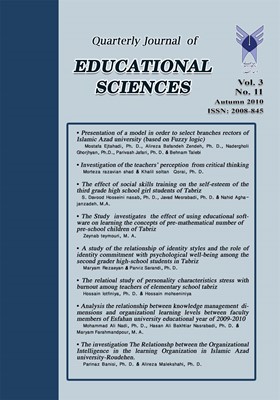A study of the relashionship between personality stress characteristics with primary teachers’ occupational burnout in Tabriz
Subject Areas : Educational PsychologyHossain lotfinia 1 , Hossain mohseninia 2
1 - استادیار دانشگاه علوم پزشکی تبریز
2 - کارشناسیارشد روان شناسی عمومی
Keywords: personality characteristics, Occupational Burnout, primary teachers,
Abstract :
The occupational burnout has been one of the main causes of mental and physical symptoms of working labor force, especially in human services occupations, such as (teaching, nursing), it is also effective in reduction of their efficiency. Considering the key role of education in training the children, and the teachers’ important role in this regard, the present study was conducted to investigate the relationship between personality stress characteristics with primary teachers’ occupational burnout. The method of the research is descriptive-correlation. The sample size included 325 people (231 female and 83 male). In order to collect the data two questionnaires namely, short form NEO-FFI personality and Mazlak’s occupational burnout test werw used, and Holmez & Rahe’s life events table was also used. Spearman correlation coefficient and concurrent multiple regression were used to analyse the data and test the hypotheses. The result showed that the conscientiousness factors have the highest influence on the occupational burnout.
احمدی، م (1386). بررسی روابط بین فرسودگی شغلی و سلامت روان شناختی در دبیران دبیرستانهای تهران. پایاننامه کارشناسیارشدروان شناسی، دانشگاه تربیت معلم
آهنگر، احد (1385). بررسی میزان فرسودگی شغلی و رابطه آن با تیپهای شخصیتی مشاوران تهران، پایاننامه کارشناسیارشد رشتهروان شناسی عمومی دانشگاه علامه طباطبایی.
بیگی فرد، سلیمه (1378). بررسی ارتباط ویژگی شخصیتی سخت روییو حمایت اجتماعی با فرسودگی شغلی در بین کارکنان مراکز توانبخشی بهزیستی شیراز، پایاننامه کارشناسیارشد رشتهروانشناسی عمومی، دانشگاه علوم بهزیستی و توانبخشی.
خوش یمن، س (1384). بررسی رابطه ابعاد شخصیتی مدیران دبیرستانهای دخترانه تبریز با عملکرد آنها، پایاننامه کارشناسیارشد دانشگاهآزاد اسلامی واحد تبریز.
صباحی وآیتالهی (1385). بررسی وضعیت سلامت روانی و رابطهی آن با فرسودگی شغلی در کارکنان بیمارستانهای شیراز. پایاننامهکارشناسیارشد روانشناسی، دانشگاه آزاد اسلامی واحد شیراز.
عادلانی، م (1386). بررسی تأثیر فرسودگی شغلی بر بهرهوری سازمانی در بین کارکنان شرکت سیمان شمال. پایاننامه کارشناسیارسد رشتهروانشناسی عمومی، دانشگاه آزاد اسلامی واحد تهران مرکزی.
فتحی آشتیانی، علی (1388). آزمونهای روانشناسی، ارزیابی شخصیت و سلامت روانی، تهران: مؤسسه انتشارات بعثت.
کوکلان، ه (1358). رفتار سازمانی و روابط انسانی. تهران: انتشارات دانشگاه تهران.
گراث- مارتات، گری (1384). راهنمای سنجش رونی. ترجمه حسنپاشا شریفی و محمدرضا نیکخو. تهران: نشر سخن (تاریخ انتشار به زبان اصلی 2003).
گروسی فرشی، میرتقی (1377). هنجاریابی آزمون جدید شخصیتی NEO و بررسی تحلیل ویژگیها و ساختار عاملی آن در بین دانشجویان دانشگاههای ایران، رساله دکتری روانشناسی، دانشگاه تربیت مدرس.
ملازاده، جواد (1381). رابطه سازگاری زناشویی با عوامل شخصیت و سبکهای مقابلهای در فرزندان شاهد. رساله دکتری روانشناسی،دانشگاه تربیت مدرس.
مهاجر، مهدی (1382). بررسی ارتباط بین ویژگیهای شخصیتی، سابقه شغلی و میزان حقوق ماهیانه با فرسودگی شغلی دبیران آموزش و پرورش شهر تبریز، پایاننامه کارشناسیارشد رشته روانشناسی عمومی، دانشگاه تبریز.
مؤمنی، سراجی و صالحی (1388). مقایسه فرسودگی شغلی پرستاران شاغل در بخشدرمان و آموزش دانشگاه علوم پزشکی اراک، مجله علمی پژوهشی دانشگاه علوم پزشکی اراک، سال دو، شماره 4، صفحه 123- 113.
نقدی، احمد (1379). بررسی رابطهی بین خلاقیت و خودکار آمدی با فرسودگی شغلی در بین معلمان مقطع متوسطه شهرستان تبریز،پایاننامه کارشناسیارشد روانشناسی، دانشکده علوم انسانی و تربیتی،دانشگاه آزاد اسلامی واحد تبریز.
Deverux, M., and etall, (2009). Social support and coping asmediators or moderators of the impact of work stressorson burn out in intelle ctual disability support staff,j, Researchin Developmental Disabiliteis.Vol(30),PP.367-377.
Erea, irit, p., (1991). Supervisors can burnout too clinical Super visor. No. 2, Vol. 9.
Fontana and Abovseri., (1992). "Stress Level sand Personality Factors in teachers", Bri.j.Ed. Psych, No.2, Vol.3. PP. 262-270.
Green have, J. H., (1975). Mental health performance journal
of applied psychology , 59 , 122-126.
Hubner, E., (1993). "Proffessionals under stress", Psyc, In the schools,Vol(30), PP.40-49.
Jackson, E, and schwab R., (1987). "Toward an understanding of the burnout", j, APP. PSYC. No(4).Vol(71), pp.630-670.
Maslach, C, andJackson, S., (1981). The measurement of experienced burnout. j. occ. Beh.
Maslach , C., Schaufeli , W. B., and leiter , M. P., (2001). Jobburnout. Annual review of psychology , 52 , 397-422.
Nberger, F., (1979). "The staff burnout syndrome in alternativeinstintions", Psychoterapy, Theory, Research andpractice, No(1),vol(12), pp. 73-82.
Nowalck – Kenneth, M., (1991). Psycholocial predictors ofheath stutus. Workand stress, No (2), Vol (5).
Sadock, B. J., and Sadock M. V. A., (2000). Comprehensivetext book of psychiatry (1the ed). Philadelphia: lippincott willams and wilkins, (pp.821-822).
Schaufeli, W.B., Maslach, C., and Marek T., (1994). Professional burnout: recent developments in theory and research (1st ed). Washington: Taylorand francis, (pp. 201-211).
Srivastova , A. X., (1991). Moderating effect coping on the relationship between stress and performance,Psychological studies, 36, (192-197).


